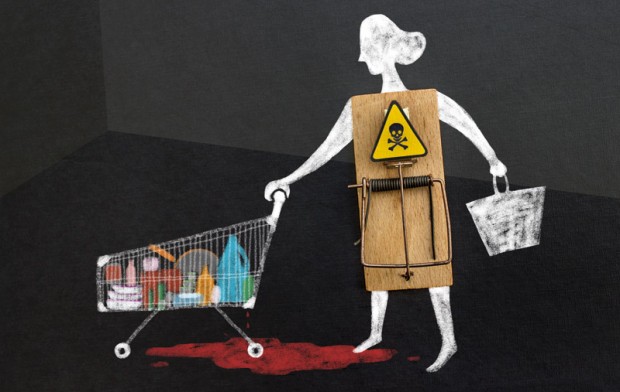There is a form of pollution that is more subtle and invisible than that of air or water. It’s inside the human body. Endocrine disruptors are substances found in food, household and office items, cleaning products, cosmetics, etc., which all build up in the body, change the way our hormones work and contribute to obesity, diabetes, cancer, fertility issues and brain development.
The scientific evidence is solid, but most governments look away. Nevertheless, the European Commission has missed all the deadlines for restricting disruptors. The unresolved issue is how to define a hormone disruptor. Depending on the definition one uses, it could cascade down into changes to EU law on pesticides, biocides and cosmetics and into the REACH list of chemicals. At the same time, some cities are prioritising the job of decontaminating the bodies of their inhabitants.
The city councils of Stockholm and Gothenburg in Sweden have banned endocrine disruptors from products purchased with public money. Paris has banned baby bottles with bisphenol A (BPA) and certain types of nappies from public childcare centres. Barcelona no longer uses the herbicide glyphosate in its parks and gardens. And nine town councils in Spain, starting with Anglès (Girona) have set up a network of cities that aspire to rid themselves of hormone disruptors, under the name “Mi ciudad cuida mis hormonas” (My town cares for my hormones).
“When a town, and especially a city, makes this kind of decision, it can have a big impact on manufacturers”, says Leonardo Trasande, a researcher at the New York University School of Medicine. “Politicians will only take decisions if public opinion changes, and the actions of cities will lead citizens to get information and ask questions”, points out Barbara Demeneix, a researcher at France’s National Center for Scientific Research (CNRS). They are both renowned researchers in the field of endocrine disruptors.
“Think of the everyday life of a child: if he were not exposed to these substances at mealtimes, if he didn’t find them when out playing in the park…, the amount of pollutants he has to live with would be greatly reduced”, explains Dolores Romano, head of Chemicals Policy for Ecologistes en Acció. “It’s true that councils lack some of the authority they need, but they can take actions that have a direct impact on the public”, adds Ruth Echeverría, training and research coordinator for Fundación Alborada, a charity that helps people suffering from environmental diseases. This pair of environmental organisations are the driving force behind the “Mi ciudad cuida mis hormonas” network.
The first warning signs of the dangers of endocrine disruptors date back over half a century. In the fifties and sixties, doctors in the United States observed that young girls who had taken diethylstilboestrol during their pregnancy (a synthetic oestrogen that was prescribed to prevent miscarriage), had a higher incidence of cancer. Around the same time it was discovered that certain compounds known as xenoestrogens had a feminizing effect on animals. Some of them were natural, such as soya isoflavones, but the artificial ones had more worrying effects.
In the early eighties, the infiltration of DDT in Lake Apopka, Florida, had such a strong effect on the fertility of alligators that the population fell drastically. That same decade, doctors detected reproductive anomalies in humans, too; specifically, in the victims of the 1976 disaster in Seveso, Italy, when high quantities of dioxins were released. The higher the concentrations of dioxins in parents’ bodies, the lower the probability of having sons. Some couples only gave birth to girls.

Cleaners are one of the groups most exposed to chemical products and, thus, are at greatest risk of being affected by hormone disrupters.
Photo: Dani Codina
Barcelona had its own incident. In 1996 a group of cleaning women at Vall d’Hebron Hospital were poisoned by solvents and other products. They experienced heavier menstrual flows, more mastitis, fatigue, hypersensitivity to smells, etc.
The common denominator across all these incidents is that the compounds involved have a special ability: to simulate the behaviour of natural hormones. Hormones are produced by the glands of the endocrine system: a dozen or so tissues ranging from the hypothalamus in the brain to the gonads in the reproductive organs. The glands produce the combination of hormones that the body needs at any given time to activate the hormonal receptors in the cells and in turn the corresponding biological processes.
A very delicate balance
The cocktail of hormones is delicately balanced: each ingredient is present to a very low and specific level (a few picograms or nanograms per millilitre of blood). This balance goes awry when an endocrine disruptor enters the mix. Disruptors imitate the function of certain hormones and stop others from working. It only takes small amounts of hormonal disruptors to interfere with our biological functions.
The picture was brought into focus in 1991, when for the first time, a team of scientists summarized the situation in the Wingspread Declaration. Since then, the evidence and the declarations have been accumulating and now include benchmark documents produced by the World Health Organization (WHO) in 2012 and the International Society of Endocrinology, in 2015.
“We know that endocrine disorders are on the rise. There is growing evidence that they are related to endocrine disruptors. So we know that disruptors carry a cost, and we also know how to reduce our exposure to disruptors”, says Trasande. “Numerous studies […] confirm the idea that exposure to chemical substances contributes towards endocrine disorders. […] There are almost eight-hundred compounds that we know or suspect interfere with hormones”, reads the WHO report.

There are around 800 substances known or thought to disrupt hormones and cause diseases and other health problems, including reproductive problems among women and men, neurodevelopment issues, obesity, diabetes and some types of cancer.
Photo: Dani Codina
The International Society of Endocrinology report lists the diseases for which there is solid proof: neurodevelopmental conditions (such as autism and hyperactivity), obesity, diabetes, male and female fertility problems (such as low sperm count, genital deformities, premature births…) and hormone-related cancers (such as breast, endometrial, ovarian, prostate, testicular and thyroid cancer).
The study points to the main compounds on which there is conclusive research: atrazine and DDT are found in herbicides and pesticides; bisphenol A (BPA) is present in food tins and in the ink on supermarket receipts; phthalates are in food packaging, cosmetics, shampoos and vinyl flooring; and polychlorinated biphenyl (PCB) and polybrominated diphenyl ethers (PBDE) are found in flame retardants and in electronic devices.
Chemical fingerprinting
“Each country has a kind of fingerprint [of disruptors] based on its [industrial] activities. A placenta with high PCB is probably Danish; one with an abundance of endosulfan, French; and one that has a lot of monoethyl phthalate, Spanish”, explains Nicolás Olea, Professor of Medicine at the University of Granada, Spain.
“It has become normal that people have certain concentrations of toxic compounds inside them”, says Miquel Porta, a researcher at the Hospital del Mar Medical Research Institute (IMIM) in Barcelona. “Of the nineteen toxic compounds we have analysed, nobody has fewer than three of them: on average, we find eleven per person”, he explains, referring to a sample of Catalan individuals between the ages of eighteen and seventy-four. “DDT, which was banned thirty-five years ago, is still today found in 88% of the population. Hexachlorobenzene, a fungicide, is in over 90% of us”, he points out.
Endocrine disruptors work in a particularly surreptitious way. Firstly, they can be dangerous even in very low doses, because the hormones that they emulate also work at very low doses and because the disruptors boost each other. That’s why the International Society of Endocrinology considers that “there is no safe threshold of exposure”.
In addition, disruptors act differently depending on life stage and gender. The WHO and the International Society of Endocrinology both state that infancy is the most delicate period, even though exposure begins even before birth. “We’ve been detecting these substances in the amniotic fluid around the foetus for many years now. There is evidence that disruptors can programme the unborn baby towards obesity, excess weight, resistance to insulin, type 2 diabetes and cardiovascular diseases”, says Porta.
Women are more exposed, for various reasons. Firstly, because of the types of jobs they hold: cleaning staff, school teachers, swimming instructors and lab technicians, for example, get more exposure. Secondly, because of their greater use of cosmetics and makeup. And lastly, because the mix of hormones in women is more sensitive to adverse effects than that of men.
Interested parties planting the seeds of doubt
Despite the weight of the evidence on hormone disruptors, there are still divisions within the field. For example, in 2015 the European Food Safety Authority (EFSA) and the World Health Organization (WHO) disagreed on the carcinogenic properties of glyphosate.
“The state of the science and the legislation is similar to what there was on climate change a decade ago. […] Faced with the evidence […] a small group of scientists – many of them with well documented connections to industry – have dedicated themselves to sowing doubt to a degree that is completely out of proportion to the actual level of scientific disagreement”, wrote Trasande in the journal Nature.
The latest document produced by the International Society of Endocrinology was given prior approval by thirteen thousand experts. “There are between eight and twelve scientists, with major conflicts of interests, who go against it”, points out Ángel Nadal, Professor of Physiology at Miguel Hernández University of Elche, Spain, and coordinator of the International Society of Endocrinology’s advisory group on endocrine disruptors.
“The impact of endocrine disruptors on health is bigger than the impact that legislating on their use would have on the chemicals industry”, remarks Demeneix. A 2016 study by Trasande puts the economic impact of endocrine disruptors – in terms of the associated costs of the diseases they cause – at 217 billion dollars in Europe and 340 billion dollars in the USA.
According to some scientists, the situation also resembles that of leaded petrol. Lead was progressively removed between the seventies and the nineties, and as a result, levels of lead in the air and in children’s blood fell markedly (to start with, 88% of children in the US had dangerously high levels of lead, and by the end, only 1% did). Over those years, children’s intelligence quotients in the US also rose by 2 to 5 points, partly because before that, lead had been affecting their brains. Translated into GDP terms, it is estimated that this improvement in general IQ because of a reduction of lead levels in the blood brought economic benefits of between 110 and 319 billion dollars a year.
Defining hormone disruptors, the bottleneck
Nevertheless, the European Commission has missed all the deadlines for restricting disruptors. The unresolved issue is how to define a hormone disruptor. Depending on the definition one uses, it could cascade down into changes to EU law on pesticides, biocides and cosmetics and into the REACH list of chemicals.

Reducing the use of plastic containers and packaging for food is one of the recommended ways to protect oneself from hormone disrupters.
Photo: Dani Codina
In June 2013 the Directorate-General for the Environment presented a draft definition based on the work of a group of experts. It was due to be approved in December 2013. “But industry didn’t like the draft, and it carried out manoeuvres to block it. Then, in the winter of 2013 the European Commission ordered a study on the socioeconomic cost of those criteria”, explains Dolores Romano. It also transferred the issue over to the Consumers, Health, Agriculture and Food Executive Agency.
Time went on and in 2014 Sweden took the Commission to the European Court of Justice for failure to act. In late 2015 the Court ruled that the definition must be published with immediate effect. Finally, in June 2016 the Commission presented a new draft.
Its proposal was a disappointment to activists and experts. “It requires a much higher level of evidence than for any other substance”, explains Dolores Romano, of Ecologistes en Acció. Ángel Nadal adds that this level is “above what is required for categorising a substance as carcinogenic. For that, it’s enough to prove that it causes anomalies in cells and animals. We want the same level for disruptors”.
But it isn’t enough to demonstrate the compound’s negative effects; one also has to know how it operates. “We have here some very complex modes of action, like the production of epigenetic changes during the foetal period and lactation, with effects that emerge years later. How long will it take to conduct all the tests on tens of thousands of compounds?” argues Nadal. In addition to all this, the European proposal includes an exemption for insecticides.
“The European Commission is too swayed by the chemical industry”, says Demeneix. Despite the fact that the Commission has already modified the definition four times, several countries (headed by the Scandinavians) have blocked its approval. In a move considered suspicious by some activists, in December 2016 the European Food Safety Authority (EFSA) set up a working party to develop a set of guidelines for putting the definition into practice, even though it hadn’t yet been ratified.
Proactive town councils
The situation is no better on national or regional levels. In 2004, the Spanish Minister for the Environment, Cristina Narbona, made the symbolic gesture of having her blood analysed: it contained dozens of contaminants. In 2010, a national environmental health plan was drawn up and then promptly disregarded. When it comes to the Catalan government, since 2012 there has been no further monitoring of endocrine disruptors in the population, although more recently there have been discussions on relaunching these checks, according to Miquel Porta.
“At the town council level, everything goes faster”, thinks Ruth Echeverría. In November 2016, Fundación Alborada and Ecologistes en Acció set up the “Mi ciudad cuida mis hormonas” network, with nine towns and cities that have passed motions to reduce exposure to endocrine disruptors: Alcalá de Guadaíra (Seville), Anglès (Girona), Brunete (Madrid), Estella-Lizarra (Navarre), Onda (Castellón), Quijorna (Madrid), Robledo de Chavela (Madrid), San Fernando de Henares (Madrid) and Zaragoza. A few others, such as Barcelona, are in the process of joining.
Three Spanish regions (Valencia, La Rioja and Aragon) have passed non-binding laws on the subject. It is worth remarking that the governing bodies of these councils and regions span Spain’s entire political spectrum, from Partido Popular to Podemos.
The small town of Anglès in Girona was the first in Spain to pass a motion, in February 2016. “We have a secretary with hyperthyroidism, same as me”, explains Astrid Desset, the elected CiU mayor. “She suggested that the Council should put some pressure on the health authorities to draw up some guidelines for local councils”. Anglès has banned Teflon cooking utensils from public schools and has changed the menu, banned glyphosate from council-run gardening services, substituted bottled water for osmosis water systems and replaced hand soaps in all public buildings. But “we don’t have anyone to help us go any further”, laments the mayor.

The municipal government banned the use of chemical pesticides in the parks and gardens of Barcelona in January 2017. In the picture, Ciutadella Park.
Photo: Dani Codina
In March 2016 Ecologistes en Acció published a guide to removing hormone contaminants, to be used by local authorities. The experiences of councils all over the world are helping to define a set of practices for reducing exposure.
The most popular measure is the banning of chemical herbicides from parks and gardens. Under the local government of Barcelona en Comú they have been banned in the city since January 2017. Until last year, for example, 2,500 litres of glyphosate were used for yearly treatment, in 200,000 tree pits and on gravelled areas, according to Izaskun Martí, Conservation Director at the Parks and Gardens Department. Today, the Council has four machines that kills weeds using hot steam and twenty-four people who do the work manually, each hired for six months on a job scheme for the unemployed. Some tree surrounds have also been covered with pine bark to prevent weeds, or planted with plants that are natural enemies of tree pests and disease.
Madrid City Council under Ahora Madrid has also got rid of glyphosate for the treatment of weeds on roads. But some councils have gone further and applied the same approach to pests. This is what the small town of Brunete has done: as well as banning certain herbicides, its PP-run council is replacing its pesticides so, for example, the nests of processionary caterpillars are removed mechanically, using nets or discs for collecting the caterpillars.
In February 2017 Brunete also pledged to introduce organic food into nursery schools, school canteens and municipal care homes, and to buy disruptor-free products for all public facilities. It may appear to be small-scale, but these are two major areas of councils’ anti-disruptor policies: to remove them from any council-run catering facilities and from municipal procurements of products such as cleaning supplies, building materials, etc.
“The residents [of Brunete] are happy up to a point. Sometimes they don’t understand the steps that are taken. Education and information are really important”, observed the training and research coordinator of the Fundación Alborada, Ruth Echeverría, who advised this town council located in the Madrid region. This is why other councils, like that of Estella-Lizarra (governed by EH Bildu) in Navarre, have embarked on a change management process, with meetings to train employees and to communicate with the residents.
The cities outside Spain that are making changes include Paris and Irvine, California. Under socialist rule, Paris’s last two city councils banned baby bottles that contain bisphenol A and certain types of nappies in public nurseries. The current council has adopted an environmental health plan (Paris Santé Environnement) that includes an advisory service for council offices on the procurement of products that are free of hormone disruptors.
In Irvine, the initiative came from a group of four committed parents who consulted three local scientists and set up an organisation called Non Toxic Irvine. After organising a petition, in February 2016 they got the City Council to replace all pesticides with organic products.
“We take great pride here in the appearance of the city and there is little tolerance for weeds”, explains Ayn Craciun, one of the mothers behind the project. “But people did understand that it was senseless to use toxic substances on gardens where kids and pets play”, adds Bruce Blumberg, a biology lecturer at the University of California-Irvine and an advisor on the project. All five council members of this Californian city (four of them Republican) voted in favour of eliminating toxins. “The pressure from a strong group of parents like ours and the arguments put forward by the scientists were crucial in persuading them”, explains Craciun. “Other cities in our region are following Irvine’s example”, says Councilwoman Christina Shea, who has had personal experience of cancer and who supported the project from the outset. The use of organic products has raised costs by no more than 6%, reports Craciun.
Another action that has been taken by various cities around the world – but only one in Spain – is currently being implemented in Barcelona, where the authorities are biomonitoring blood samples from 240 people who are representative of the city’s population. The analysis of the samples is being coordinated by Miquel Porta, a researcher at IMIM, and it will provide an estimation of the presence of disruptors in the organisms of the city’s residents. The procedure had already been carried out in 2002 and 2006. “We’ll have to see if the downward trend recorded between the two previous studies continues”, reflects Porta.
“The lack of EU-wide regulations puts the ball firmly in the court of local governments. They can reduce the use of certain substances, stimulate the market for safer alternatives and, basically, set a good example to the public. Cities have a lot of work to do when it comes to endocrine disruptors”, concludes Dolores Romano.




